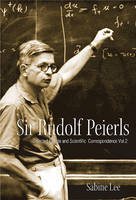
Sir Rudolf Peierls: Selected Private And Scientific Correspondence (Volume 2)
Seiten
2009
World Scientific Publishing Co Pte Ltd (Verlag)
978-981-279-706-3 (ISBN)
World Scientific Publishing Co Pte Ltd (Verlag)
978-981-279-706-3 (ISBN)
Offers the private and scientific correspondence of Sir Rudolf Peierls, one of the greatest theoretical physicists of the 20th century. This book includes correspondence with his parents, his wife, the Russian-born physicist Genia Kannegieser, life-long friends such as Hans Bethe, and many physicists, including Wolfgang Pauli and Niels Bohr.
This edition of the private and scientific correspondence of Sir Rudolf Peierls gives a unique insight into the life and work of one of the greatest theoretical physicists of the 20th century. Rudolf Peierls' scientific work contributed to the early developments in quantum mechanics, and he is well known and much appreciated for his contributions to various disciplines, including solid state physics, nuclear physics, and particle physics. As an enthusiastic and devoted teacher, he passed on his knowledge and understanding and inspired the work of collaborators and students alike. As an effective administrator he was responsible, almost single-handedly, for the establishment of an outstanding successful centre of theoretical physics in Birmingham, and later contributed much to theoretical physics in Oxford.A meticulous collector of correspondence, Sir Rudolf left a fascinating collection of letters, in some cases spanning more than seven decades. This collection includes correspondence with his parents, his wife, the Russian-born physicist Genia Kannegieser, life-long friends such as Hans Bethe, and many great physicists, including Wolfgang Pauli, Niels Bohr, Werner Heisenberg, Lev Landau, and George Placzek, to name but a few.The second volume, which covers the years 1945 to 1995, contains fascinating documents from the early postwar period, when Peierls, like many of his colleagues elsewhere, attempted to rebuild academic life in the aftermath of the Second World War. Materials from the 1950s provide evidence for the significance of the research undertaken by Peierls' group at Birmingham, and for the positive impact of his determined implementation of international exchange on the development of theoretical physics. Later documents illustrate the role played by Peierls in nuclear disarmament, and as a link between East and West through his own personal contacts and within international organisations such as the Pugwash Movement. The extensive apparatus provides an invaluable background which allows the reader to put the documents into their multi-faceted social, political and scientific context.
This edition of the private and scientific correspondence of Sir Rudolf Peierls gives a unique insight into the life and work of one of the greatest theoretical physicists of the 20th century. Rudolf Peierls' scientific work contributed to the early developments in quantum mechanics, and he is well known and much appreciated for his contributions to various disciplines, including solid state physics, nuclear physics, and particle physics. As an enthusiastic and devoted teacher, he passed on his knowledge and understanding and inspired the work of collaborators and students alike. As an effective administrator he was responsible, almost single-handedly, for the establishment of an outstanding successful centre of theoretical physics in Birmingham, and later contributed much to theoretical physics in Oxford.A meticulous collector of correspondence, Sir Rudolf left a fascinating collection of letters, in some cases spanning more than seven decades. This collection includes correspondence with his parents, his wife, the Russian-born physicist Genia Kannegieser, life-long friends such as Hans Bethe, and many great physicists, including Wolfgang Pauli, Niels Bohr, Werner Heisenberg, Lev Landau, and George Placzek, to name but a few.The second volume, which covers the years 1945 to 1995, contains fascinating documents from the early postwar period, when Peierls, like many of his colleagues elsewhere, attempted to rebuild academic life in the aftermath of the Second World War. Materials from the 1950s provide evidence for the significance of the research undertaken by Peierls' group at Birmingham, and for the positive impact of his determined implementation of international exchange on the development of theoretical physics. Later documents illustrate the role played by Peierls in nuclear disarmament, and as a link between East and West through his own personal contacts and within international organisations such as the Pugwash Movement. The extensive apparatus provides an invaluable background which allows the reader to put the documents into their multi-faceted social, political and scientific context.
Resettling at Birmingham: Postwar Physics in the UK; Birmingham: A 'Most Stimulating Theoretical Group'; 1954-1963: Spreading the Seeds of the Birmingham Group; 1963-1974: Oxford; 1974-1986: Retirement -- Two Birds of Passage; 1986-1995: The Tree Needs to Grow New Rings.
| Erscheint lt. Verlag | 12.5.2009 |
|---|---|
| Verlagsort | Singapore |
| Sprache | englisch |
| Themenwelt | Naturwissenschaften ► Physik / Astronomie ► Atom- / Kern- / Molekularphysik |
| Naturwissenschaften ► Physik / Astronomie ► Hochenergiephysik / Teilchenphysik | |
| Naturwissenschaften ► Physik / Astronomie ► Thermodynamik | |
| ISBN-10 | 981-279-706-8 / 9812797068 |
| ISBN-13 | 978-981-279-706-3 / 9789812797063 |
| Zustand | Neuware |
| Haben Sie eine Frage zum Produkt? |
Mehr entdecken
aus dem Bereich
aus dem Bereich
Buch | Softcover (2024)
Wiley-VCH (Verlag)
CHF 83,85


